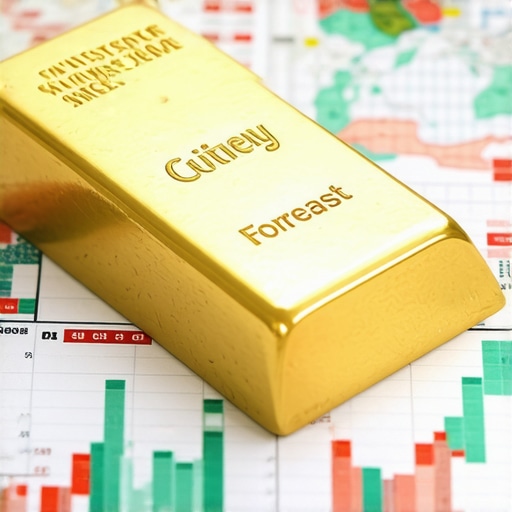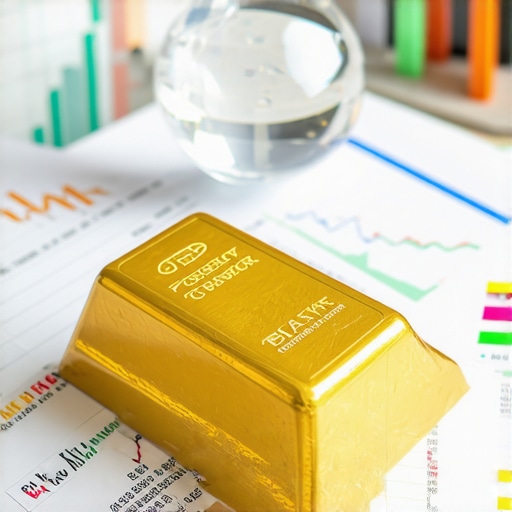The Golden Horizon: What Awaits Gold Prices in 2025?
In an era marked by economic uncertainties, geopolitical tensions, and fluctuating financial markets, gold remains a perennial beacon of stability and value. As we peer into 2025, investors are keenly focused on deciphering the gold price forecast to align their portfolios with anticipated market movements. This article delves deep into the multifaceted factors shaping gold’s trajectory, offering nuanced perspectives and actionable intelligence for savvy investors.
Decoding the Economic Undercurrents Driving Gold’s Value
Gold prices do not move in isolation; they respond dynamically to macroeconomic variables such as inflation rates, currency strength, interest rates, and global crises. The persistent inflationary pressures expected through 2025, coupled with potential interest rate adjustments by central banks, create a complex backdrop that typically enhances gold’s appeal as a hedge against currency depreciation and market volatility. Investors must monitor the interplay between the US dollar index and real yields closely, as historically, a weakening dollar tends to bolster gold prices.
How Will Geopolitical Tensions and Global Demand Shape Gold in 2025?
Geopolitical conflicts and trade uncertainties often trigger safe-haven demand for gold. Emerging tensions in key regions could spark spikes in gold buying, amplifying its price. Simultaneously, rising demand from burgeoning markets, notably in Asia’s gold-consuming countries, will exert upward pressure. Understanding these demand trends is critical; for instance, shifts in jewelry consumption, central bank gold purchases, and technological applications all influence price movements. For a comprehensive analysis of gold demand trends and their impact, readers can explore this detailed resource.
What Are the Most Effective Investment Vehicles for Capitalizing on the 2025 Gold Forecast?
Choosing the right investment form can significantly affect portfolio performance amid gold’s price fluctuations. Physical gold—coins and bullion—offers tangible security but comes with storage and liquidity considerations. Conversely, gold ETFs and mutual funds provide ease of trade and diversification benefits. Advanced investors might explore gold futures trading, which offers leverage opportunities but requires expertise to navigate volatility effectively. To compare these options in detail, consider reading Types of Gold Investments Explained: Futures, ETFs, and Bullion.
Strategic Preparations: How Should Investors Position Themselves for Gold in 2025?
In light of the anticipated market dynamics, investors should adopt a diversified approach, balancing physical assets with financial instruments tailored to their risk tolerance and investment horizon. Staying informed about supply-demand shifts, monitoring central bank policies, and employing tactical entry and exit strategies will be vital. Leveraging expert insights and resources to understand gold trading techniques can enhance decision-making and protect wealth during volatile periods.
If you’re eager to deepen your understanding of gold investment strategies and stay ahead in 2025, don’t hesitate to share your thoughts or questions in the comments below. Engaging with a community of informed investors can provide invaluable perspectives and support your journey.
For further authoritative insights, the World Gold Council offers comprehensive research on market trends and forecasts, accessible at Gold Hub Research.
Reflecting on Personal Gold Investment Experiences Amid Market Uncertainty
When I first dipped my toes into gold investment, I was overwhelmed by the sheer variety of options and unpredictable market swings. Over time, I realized that understanding my own risk tolerance and investment goals was paramount. For instance, during a sudden market dip last year, I chose to increase my allocation in physical gold bars, appreciating their tangible security despite storage costs. This experience taught me the value of patience and the importance of not reacting impulsively to short-term volatility.
In contrast, I also experimented with gold ETFs, enjoying their liquidity and ease of trading. This dual approach helped me balance stability with flexibility, allowing me to capitalize on market movements without overexposing myself to risk. These personal lessons highlight why a diversified gold investment strategy is not just theoretical but practical for navigating the complex 2025 gold landscape.
How Can Investors Effectively Manage Risks While Maximizing Gold’s Potential?
Risk management is often overlooked in the excitement of gold’s allure, but it’s crucial for long-term success. One practical method I’ve found effective is setting clear entry and exit points based on technical analysis and market signals. Keeping an eye on global economic indicators, central bank announcements, and geopolitical developments helps me anticipate price movements and adjust my holdings accordingly.
Moreover, integrating educational resources into your routine can deepen your understanding. For example, the World Gold Council’s Gold Hub Research offers invaluable data and forecasts that have informed many of my decisions. It’s also wise to avoid putting all your eggs in one basket; spreading investments across physical gold, ETFs, and selective gold mining stocks can cushion against sector-specific downturns.
What’s Your Gold Investment Strategy for 2025?
I’m genuinely curious—how are you planning to position yourself in the gold market this year? Are you leaning toward physical assets, or do you prefer more liquid options like ETFs or futures trading? Sharing your approach or questions can foster a supportive community where we all learn from each other’s experiences. Feel free to comment below or join discussions on related topics such as long-term portfolio growth strategies and protecting wealth during volatility.
Embracing Continuous Learning: The Key to Thriving in Gold Investments
One of the most rewarding aspects of my gold investment journey has been the ongoing learning process. Markets evolve, new investment vehicles emerge, and global circumstances shift. Staying open to new information and adapting strategies accordingly has made all the difference. Whether it’s discovering the nuances of gold futures trading or understanding the impact of supply-demand dynamics, continuous education empowers smarter, more confident decisions.
If you’re eager to explore practical gold trading techniques, I recommend checking out resources like Gold Futures Trading Strategies, which offer actionable advice for navigating today’s volatile markets. Remember, investing is as much about mindset as it is about numbers—patience, discipline, and curiosity are your best allies.
Harnessing Quantitative Models: Predictive Analytics for Gold Pricing in 2025
While traditional indicators like inflation, interest rates, and geopolitical tensions have long guided gold price expectations, the advent of sophisticated quantitative models has revolutionized forecasting accuracy. Techniques such as machine learning algorithms and time-series analysis enable investors to parse vast datasets—ranging from commodity supply chain metrics to social sentiment analysis—uncovering subtle patterns that elude conventional methods. For instance, Bayesian networks can integrate economic indicators with geopolitical event probabilities to refine price projections dynamically, offering a more nuanced and adaptive framework for 2025’s gold market outlook.
These models, however, require careful calibration and domain expertise to avoid overfitting or misinterpretation. Importantly, integrating macroeconomic fundamentals with real-time data streams enhances the predictive power, empowering investors to make preemptive moves rather than reactive adjustments.
Deciphering Central Bank Gold Reserves: Strategic Implications for 2025
Central banks have increasingly asserted themselves as pivotal players in gold markets, not simply as passive holders but as strategic actors influencing supply-demand equilibrium. Recent trends reveal a subtle but consistent accumulation by emerging economies, driven by desires to diversify foreign reserves and hedge against currency instability. This accumulation can dampen market volatility but also signal geopolitical shifts, such as moves toward de-dollarization.
Understanding the motives behind these reserve changes is critical: Are these purchases defensive, addressing domestic economic risks, or offensive, aiming to recalibrate international monetary influence? The World Gold Council’s detailed reports (Central Bank Gold Reserves Analysis) provide granular data that investors can leverage to anticipate market movements precipitated by these institutional behaviors.
How Do Macro-Financial Shocks Influence Gold Price Volatility in the Near-Term?
Gold’s traditional role as a safe haven intensifies during macro-financial shocks, but the amplitude and duration of price spikes depend on the shock’s nature and market context. For example, sudden interest rate hikes can depress gold prices by increasing opportunity costs of holding non-yielding assets. Conversely, systemic banking crises tend to propel gold prices upward due to heightened uncertainty and liquidity flight.
Empirical studies, such as those published in the Journal of Financial Economics, indicate that the cross-correlation between gold prices and financial shocks varies significantly depending on concurrent monetary policies and investor sentiment. Hence, sophisticated investors must adopt multi-factor risk assessment models incorporating volatility indexes, credit spreads, and geopolitical event probabilities to navigate these turbulent periods effectively.
Leveraging Algorithmic Trading and Sentiment Analysis in Gold Markets
The proliferation of algorithmic trading in commodity markets, including gold, introduces new dimensions of liquidity and volatility. High-frequency trading (HFT) algorithms capitalize on minute price discrepancies, which can amplify short-term fluctuations but also provide arbitrage opportunities for informed traders.
Complementary to quantitative models, sentiment analysis using natural language processing (NLP) on news feeds, social media, and central bank communications offers real-time insights into market psychology. By integrating these with technical indicators, traders can craft hybrid strategies that anticipate momentum shifts before they materialize in price charts.
However, these technologies demand robust infrastructure and continuous refinement to adapt to evolving market microstructure and regulatory environments.
If you are intrigued by the intersection of technology and gold investment strategy, consider delving into specialized resources such as Gold Futures Trading Strategies to enhance your tactical acumen.
Unveiling Cutting-Edge Quantitative Techniques Transforming Gold Price Predictions
Beyond traditional economic indicators, the integration of advanced statistical models and machine learning algorithms has ushered in a new era of gold price forecasting. Investors employing these techniques analyze multifactor datasets encompassing supply chain metrics, macroeconomic variables, and even global sentiment indices to identify latent patterns that conventional analyses might miss. For instance, the application of Bayesian inference and neural networks allows for dynamic adjustment of forecasts in response to real-time developments, enhancing predictive accuracy in the inherently volatile gold market.
Central Banks as Strategic Gold Market Architects: Interpreting Reserve Movements
Central bank behavior continues to be a pivotal factor influencing gold price dynamics in 2025. Recent trends highlight an assertive accumulation posture by emerging market economies seeking to diversify reserves and mitigate dollar dependency. This strategic repositioning signals potential shifts in global monetary power balances and introduces nuanced supply-demand considerations. Monitoring detailed data on central bank gold reserves, such as those available from the World Gold Council’s Central Bank Gold Reserves Analysis, empowers investors to anticipate market ripples stemming from institutional maneuvers.
How Do Macro-Financial Shocks Alter Gold Price Volatility and Investor Behavior?
Macro-financial shocks exert asymmetric effects on gold’s volatility profile and investor sentiment. For example, abrupt interest rate escalations often suppress gold’s appeal due to rising opportunity costs, whereas systemic financial crises typically drive demand upward as investors seek refuge in non-yielding safe havens. Empirical research, including findings published in the Journal of Financial Economics, underscores the importance of context-specific factors such as concurrent monetary policy and market sentiment in modulating these responses. Sophisticated investors incorporate multi-dimensional risk models integrating volatility indices, credit spreads, and geopolitical event probabilities to navigate these complex dynamics effectively.
Harnessing Algorithmic Trading and Sentiment Analytics: The Frontier of Gold Market Strategy
The infusion of algorithmic trading strategies, especially high-frequency trading (HFT), has significantly impacted gold market liquidity and short-term price oscillations. These automated systems exploit micro-level price inefficiencies, creating both challenges and opportunities for strategic traders. Parallel advances in sentiment analysis leveraging natural language processing (NLP) on diverse data sources—ranging from central bank communications to social media—offer real-time gauges of market psychology. By synthesizing algorithmic insights with technical and fundamental analyses, investors can construct hybrid trading frameworks that anticipate momentum shifts with greater precision. However, deploying these technologies demands robust infrastructure and continual refinement to adapt to evolving regulatory landscapes and market microstructures.
If you’re eager to deepen your tactical expertise and capitalize on these advanced methodologies, explore specialized resources like Gold Futures Trading Strategies. Engage actively with these insights to refine your approach and unlock new dimensions of gold investment success.
Frequently Asked Questions (FAQ)
What factors most influence gold prices in 2025?
Gold prices in 2025 are primarily influenced by macroeconomic variables such as inflation rates, central bank interest rate policies, currency strength—particularly the US dollar index—geopolitical tensions, and global demand trends including central bank reserve accumulation and consumer consumption patterns. Advanced quantitative models and real-time sentiment analysis also increasingly play a role in shaping price expectations.
How do central bank gold reserves impact the gold market?
Central banks act as strategic market architects by adjusting their gold reserves to diversify foreign assets and hedge against currency fluctuations. Emerging economies’ accumulation can reduce market volatility but also signal geopolitical shifts like de-dollarization, thereby influencing supply-demand dynamics and price movements.
What are the advantages and risks of investing in physical gold versus ETFs or futures?
Physical gold offers tangible security and is less susceptible to counterparty risks but requires secure storage and has lower liquidity. ETFs and mutual funds provide ease of trading and diversification but carry market risks and potential management fees. Futures offer leverage and trading flexibility but require expertise to manage volatility and margin requirements effectively.
How can algorithmic trading and sentiment analysis enhance gold investment strategies?
Algorithmic trading, including high-frequency trading, increases market liquidity and exploits short-term price inefficiencies. Sentiment analysis using natural language processing on news, social media, and central bank communications provides real-time market psychology insights. Combining these with technical and fundamental analysis enables more precise anticipation of price momentum shifts.
What role do macro-financial shocks play in gold price volatility?
Macro-financial shocks like sudden interest rate hikes or systemic banking crises significantly influence gold’s volatility. Interest rate hikes can depress gold prices by raising opportunity costs, whereas financial crises typically boost gold demand as a safe haven. The impact depends on concurrent monetary policies and investor sentiment, necessitating multidimensional risk models.
Are advanced quantitative models reliable for forecasting gold prices?
Advanced models incorporating machine learning, Bayesian inference, and time-series analysis improve forecasting accuracy by integrating multifactor datasets and real-time data. However, they require expert calibration to avoid pitfalls like overfitting and should complement, not replace, fundamental economic analysis.
How should investors manage risks while maximizing gold’s potential in 2025?
Effective risk management involves diversification across physical gold, ETFs, and selective mining stocks, setting clear entry and exit points based on technical signals, and staying informed about economic indicators and geopolitical developments. Continuous education and leveraging authoritative research enhance decision-making agility.
What impact does global gold demand, especially from Asia, have on prices?
Rising demand from Asian markets, particularly for jewelry, technology, and central bank purchases, exerts upward pressure on gold prices. Shifts in consumption patterns and investment preferences in these regions are critical indicators for anticipating future market dynamics.
How can beginners start investing in gold effectively?
Beginners should start by understanding their risk tolerance and investment goals, consider low-cost and liquid options like gold ETFs, gradually explore physical gold acquisition, and educate themselves on market factors. Engaging with expert resources and communities can provide valuable guidance during this learning process.
What is the significance of continuous learning in gold investments?
Continuous learning allows investors to adapt to evolving markets, technologies, and geopolitical landscapes, improving strategy refinement and risk mitigation. Embracing new tools like algorithmic trading insights and staying updated with authoritative research ensures informed and confident investment decisions.
Trusted External Sources
- World Gold Council (WGC) – Gold Hub Research: As the leading authority on gold market data and analysis, the WGC provides comprehensive research on global gold demand, supply, central bank reserves, and market forecasts, essential for informed investment decisions.
- Journal of Financial Economics: This peer-reviewed journal publishes empirical studies on financial markets, including the impacts of macro-financial shocks on gold price volatility and investor behavior, offering academic rigor to market understanding.
- International Monetary Fund (IMF) – Reserve Management Reports: The IMF provides detailed insights into central bank reserve compositions and international monetary policy trends, helping to contextualize gold’s role in global finance.
- Bloomberg Commodities and Financial Data Services: Bloomberg offers real-time market data, algorithmic trading analytics, and sentiment indicators crucial for tactical gold trading and quantitative model integration.
- Oxford Economics – Commodity Forecasting Division: Known for advanced economic modeling, Oxford Economics delivers expert forecasts and scenario analyses that enhance strategic planning for gold investments.
Conclusion
As gold prices face a complex interplay of inflationary pressures, geopolitical uncertainties, and evolving global demand in 2025, investors must adopt a multifaceted strategy grounded in both traditional fundamentals and cutting-edge analytics. Central bank reserve movements and macro-financial shocks remain pivotal in shaping market volatility, while algorithmic trading and sentiment analysis introduce new strategic dimensions. Balancing physical assets with liquid financial instruments, alongside continuous education and risk management, empowers investors to harness gold’s enduring value effectively. By leveraging authoritative research and embracing adaptive investment approaches, one can navigate the 2025 gold landscape with confidence and insight. We invite you to share your perspectives, engage with expert resources, and explore further to optimize your gold investment journey in the dynamic markets ahead.










